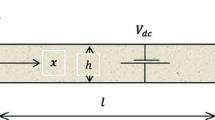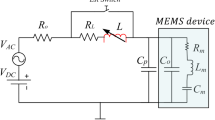Abstract
We study in detail the first vibration modes of a piezoelectric resonator based on two coupled micro-cantilevers, also known as tuning-forks. A multiple electrode geometry lying on a layer of piezoelectric AlN allows the selective excitation of different modes, including in-plane modes. A complete optical characterization of the devices in the z- and also the x-direction has been performed employing a Doppler vibrometer. The measurements confirm the excitation and inhibition of different modes depending on the actuation signals distribution on the electrodes. The influence of the dimensions of the resonator on the coupling between the microcantilevers has also been studied. Quality factors above 4,300 have been measured for the first anti-phase in-plane mode.





Similar content being viewed by others
References
Beardslee LA et al (2010) Geometrical optimization of resonant cantilevers vibrating in in-plane flexural modes. IEEE Sens 2010:1996–1999
Castellanos-Gómez A, Agraït N, Rubio-Bollinger G (2009) Dynamics of quartz tuning fork force sensors used in scanning probe microscopy. Nanotechnology 20:215502
Dufour M, Heinrich SM, Josse F (2007) Theoretical analysis of strong-axis bending mode vibrations for resonant microcantilever (bio) chemical sensors in gas or liquid phase. J Microelectromech Syst 16:1
Karrai K, Grober RD (2005) Piezoelectric tip-sample distance control for near field optical microscopes. Appl Phys Lett 66(14):1842–1844
Leighton GJT, Kirby PB, Fox CHJ (2007) In-plane excitation of thin silicon cantilevers using piezoelectric thin films. Appl Phys Lett 91:183510
Leissa AW 1969 Vibration of plates NASA Technical Report SP160
Momosaki E (1997) A brief review of progress in quartz tuning fork resonators. In: Proceedings of the 1997 IEEE international frequency control symposium, pp 552–565
Sánchez-Rojas JL et al (2010) Modal optimization and filtering in piezoelectric microplate resonators. J Micromech Microeng 20:055027
Vignola JF, Judge JA (2008) Architectural considerations of micro- and nanoresonators for mass detection in the presence of a fluid. J Appl Phys 104:124305
Acknowledgments
This work has been supported by Junta de Comunidades de Castilla-La Mancha project no PEIC11-0022-7430. MICINN (Spain) supported by project contract DPI2009-07497, a FPI Grant (Ref. BES-2010-030770) awarded to Tomás Manzaneque and a Juan de la Cierva research contract awarded to Marta Gil (JCI-2009-04502). The authors would also like to thank Dr. Erwin Peiner (Technical University of Braunschweig) for the support during device fabrication.
Author information
Authors and Affiliations
Corresponding author
Rights and permissions
About this article
Cite this article
Gil, M., Manzaneque, T., Hernando-García, J. et al. Selective modal excitation in coupled piezoelectric microcantilevers. Microsyst Technol 18, 917–924 (2012). https://doi.org/10.1007/s00542-011-1411-y
Received:
Accepted:
Published:
Issue Date:
DOI: https://doi.org/10.1007/s00542-011-1411-y




